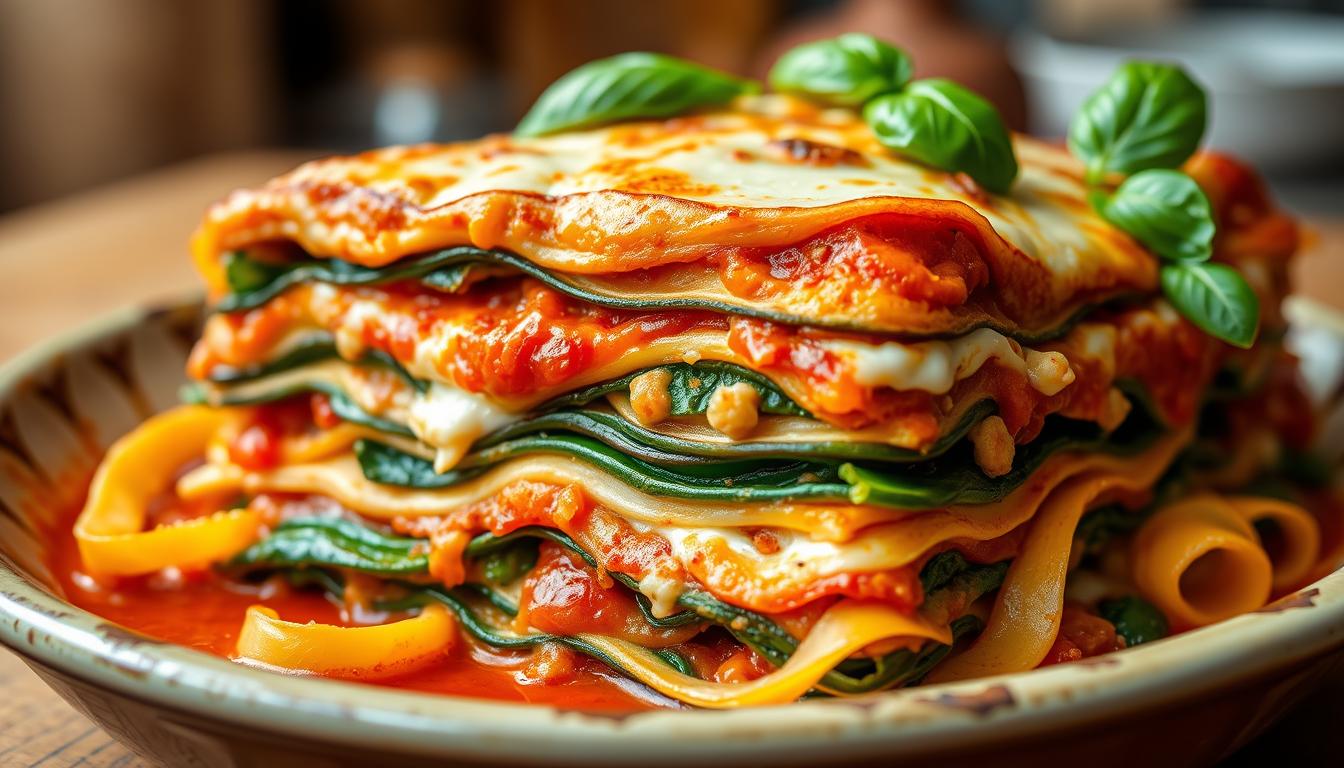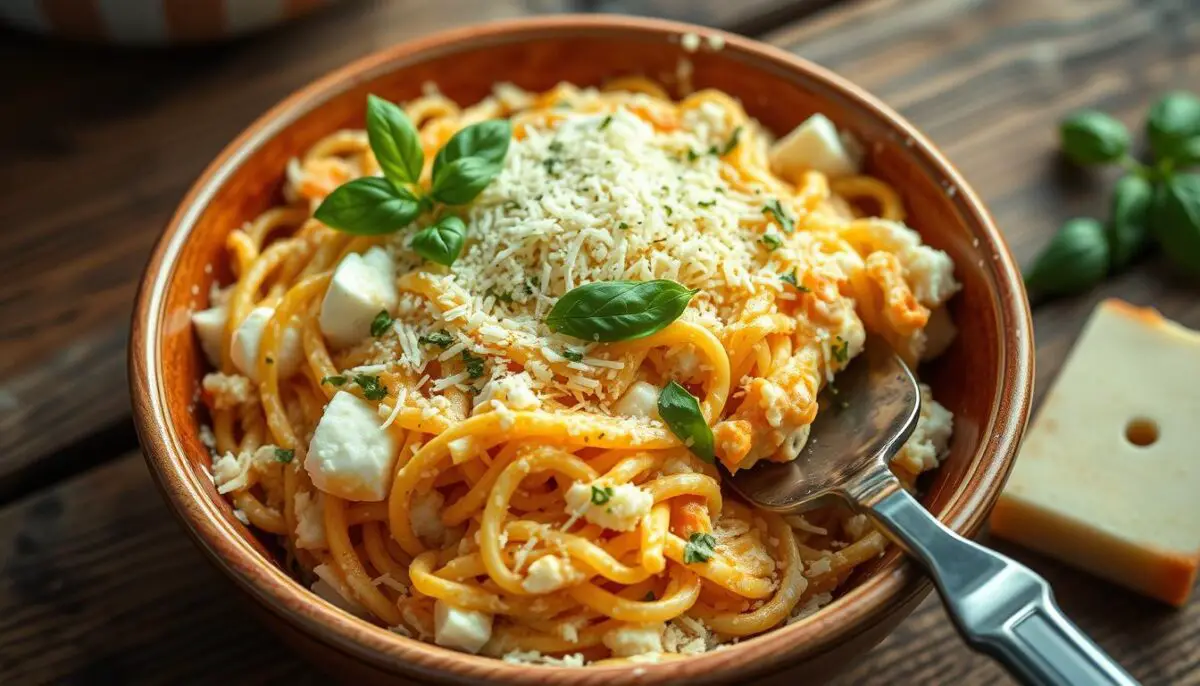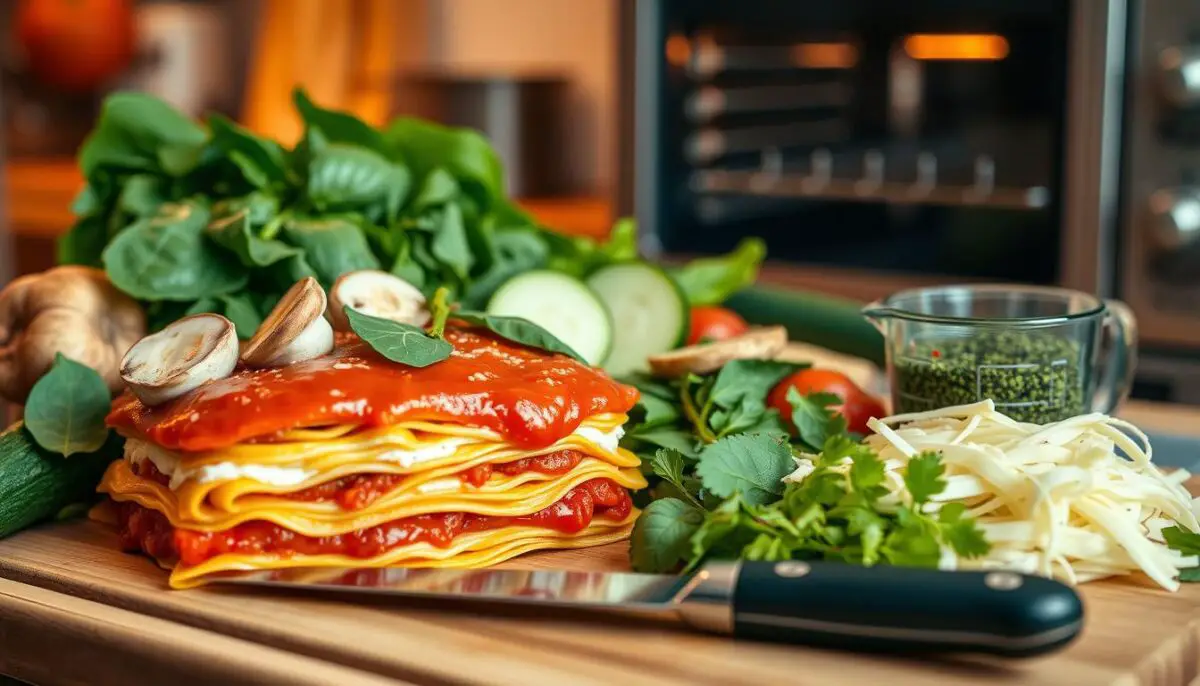Vegetarian lasagna is a tasty and satisfying choice for those who don’t eat meat. It’s becoming more popular as more people choose plant-based diets. This dish is loved by both vegetarians and meat-lovers because of its rich flavors and variety of ingredients.
By using fresh veggies and creamy cheeses, you can make a healthy lasagna. It’s perfect for any event, whether it’s a big dinner party or a cozy family meal. Vegetarian lasagna is a dish that everyone will enjoy.
Key Takeaways
- Vegetarian lasagna is a flavorful and satisfying meat-free option.
- It caters to both vegetarians and meat-eaters, making it a versatile dish.
- Incorporating fresh vegetables enhances the dish’s taste and nutrition.
- Creamy cheeses contribute to the richness of healthy lasagna recipes.
- Ideal for various occasions, from casual family dinners to elegant gatherings.
Introduction to Vegetarian Lasagna
Vegetarian lasagna is a mix of textures and flavors, perfect for those trying plant-based cooking. It’s a comforting, hearty choice for those who prefer not to eat meat. The dish has layers of creamy cheeses, fresh veggies, and tangy sauces.
This dish is great for families. It’s a way for parents to get kids to eat healthy while keeping the lasagna taste they love. You can stick to classic recipes or try new ones, making it fun for everyone.
Vegetarian lasagna appeals to many. Each layer brings out a mix of tastes, even for those who love meat. It’s a dish that feeds both the body and the soul.
History of Lasagna and Its Variations
The history of lasagna goes back to ancient times. In Ancient Greece and Rome, layered dishes were all the rage. These early versions used pasta with different fillings, laying the groundwork for today’s traditional lasagna.
Over time, lasagna spread across Italy, changing with each region’s flavors and traditions. This led to many lasagna variations that make Italian food so rich and varied.
In Emilia-Romagna, you’ll find lasagna alla Bolognese. It’s made with ground meat, béchamel sauce, and Parmigiano-Reggiano. Sicily, on the other hand, adds eggplant and ricotta to its lasagna, showing off local tastes.
Italian immigrants brought lasagna to the United States, where it evolved further. Today, you can find everything from classic to vegetarian lasagna. These new takes keep the spirit of traditional lasagna alive while appealing to today’s tastes.
Why Choose Vegetarian Lasagna?
Vegetarian lasagna is a great choice for many reasons. It’s healthier than traditional lasagna because it has less saturated fat and more fiber. This makes it better for your heart and digestion.
Eating more plant-based meals is good for your health. It can lower the risk of chronic diseases and boost your energy. Think about how it can improve your life and health in the long run.
Choosing vegetarian lasagna is also an ethical choice. It helps the environment and supports animal welfare. It lets you eat in a way that matches your values and beliefs.
Vegetarian lasagna is a tasty and healthy option. It’s not just good for you, but also for the planet. It’s a choice that makes you feel good and does good for the world.
Key Ingredients for a Delicious Vegetarian Lasagna
Making a tasty vegetarian lasagna starts with picking the right ingredients. You can choose from many pasta types to change the texture and taste. Options like whole wheat, gluten-free, or semolina pasta cater to different diets.
Then, think about the cheese. Ricotta, mozzarella, or goat cheese make the lasagna creamy and rich. Mixing these cheeses creates a delicious mix that makes each layer special.
The sauce is the heart of the lasagna. A good tomato sauce is vibrant and goes well with fresh herbs. Basil, oregano, and garlic add depth to the flavor, making every bite memorable.
To show the ingredient choices, here’s a table with different vegetarian lasagna ingredients based on taste and texture:
| Ingredient Type | Examples | Notes |
|---|---|---|
| Pasta Types | Whole Wheat, Gluten-Free, Regular Semolina | Choose based on dietary preferences and texture desires. |
| Cheese Options | Ricotta, Mozzarella, Parmesan | Mixing cheeses offers a richer flavor. |
| Sauces for Lasagna | Tomato Sauce, Pesto Sauce | Use fresh or jarred, ensure high quality for best results. |
| Herbs & Spices | Basil, Oregano, Garlic | Add to sauces or layer for enhanced flavor. |
With careful selection of these ingredients, you’ll create a vegetarian lasagna that wows with its flavors and textures. The right mix ensures every bite is a joy, pleasing both vegetarians and meat-lovers.
Vegetable Options for Your Lasagna
Choosing the right vegetables is key to a tasty vegetarian lasagna. Using a mix of seasonal vegetables adds flavor and nutrition. Here are some top picks for your lasagna:
- Spinach: Adds a mild flavor and vibrant color.
- Zucchini: Offers a subtle sweetness and a delightful texture.
- Mushrooms: Introduces a meaty richness and umami flavor.
- Bell Peppers: Provides a crunchy contrast and bright color.
To make a great lasagna, layer your veggies well. Start by sautéing them to bring out their flavors. This step keeps them moist and tasty during baking. Mix different textures for a better taste in every bite.
Using seasonal veggies makes your lasagna even better. They’re fresher and taste amazing. Feel free to try new combinations and adjust the amounts. This way, you can make your lasagna your own, based on what you like and need.
| Vegetable | Flavor Profile | Texture | Seasonal Availability |
|---|---|---|---|
| Spinach | Mild and earthy | Soft and tender | Spring and Fall |
| Zucchini | Subtly sweet | Crunchy, becomes soft when cooked | Summer |
| Mushrooms | Umami-rich | Meaty and chewy | Year-round |
| Bell Peppers | Sweet and crunchy | Crunchy | Summer and Fall |
Pay attention to these details for a lasagna that’s full of flavor and texture. Your dish will be a hit at any meal.
Preparing the Perfect Cheese Mixture
A well-prepared cheese mixture is key to a great vegetarian lasagna. It combines ricotta cheese, eggs, and herbs for a creamy texture. This mix brings together flavors that enhance the vegetables and pasta.
Begin with fresh ricotta cheese for the right consistency. Adding eggs helps bind the mixture. This makes the lasagna layers creamy and enjoyable. Fresh herbs like basil or parsley add a flavorful twist.
For those who prefer plant-based options, vegan cheese alternatives are a great choice. Made from nuts or soy, they offer a creamy texture without dairy.
- Key Ingredients for the Cheese Mixture:
- Ricotta cheese
- Eggs (or flaxseed meal for vegan version)
- Herbs (basil, parsley, oregano)
Layering different cheeses in the lasagna adds depth to the flavor. Mozzarella or Parmesan, combined with the cheese mixture, boosts both texture and taste. This makes your dish feel like it’s from a restaurant.
In short, the right cheese mixture is essential for a creamy, delicious vegetarian lasagna. It ensures each slice is full of flavor, making the dish hard to resist.
Step-by-Step Guide to Assembling Vegetarian Lasagna
Making a tasty vegetarian lasagna needs care and attention. Follow these steps for a dish full of flavor and texture.
First, get your workspace ready. Collect all your ingredients, like cooked noodles, sauce, veggies, and cheese. A tidy area helps a lot.
- Layer the Base: Start with a thin layer of sauce at the bottom of your dish. This stops noodles from sticking.
- Add Noodles: Put a layer of cooked lasagna noodles over the sauce. Make sure they don’t overlap.
- Spread Sauce: Put a lot of sauce over the noodles, covering them fully.
- Layer Vegetables: Spread out your chosen veggies, like spinach or mushrooms, evenly.
- Add Cheese: Top the veggies with a mix of ricotta and mozzarella cheese.
- Repeat the Process: Keep layering noodles, sauce, veggies, and cheese until you’ve used everything. Finish with a layer of sauce and cheese on top.
Make sure to spread everything evenly. This avoids soggy pasta and uneven layers. This guide helps you achieve a great texture in every bite.
The last step is baking the lasagna until the top is golden and bubbly. This takes about 30 to 40 minutes at 375°F. Let it cool a bit before slicing. Then, enjoy your homemade lasagna!
Baking Tips for the Best Vegetarian Lasagna
Baking lasagna to perfection is all about the right temperature and time. It’s key to know the ideal lasagna temperature. Preheat your oven to a steady 375°F for the best results. This temperature helps the flavors blend and creates a golden crust.
The baking time should be between 45 to 60 minutes. For a crisp top, bake uncovered for the last 15 minutes. Covering it with foil first prevents the cheese from burning. Then, remove the foil to get that bubbly texture.
After baking, patience is important. Let your lasagna rest for at least 15 minutes before slicing. This step improves flavors and keeps the structure, making for cleaner cuts. Use a sharp knife for precise cuts.
Here are some helpful tips summarized:
- Preheat the oven to 375°F before baking.
- Cover the lasagna with foil for initial baking.
- Uncover the dish for the last 15 minutes for a crispy top.
- Let the lasagna rest before serving.
| Step | Detail |
|---|---|
| 1 | Preheat your oven to 375°F. |
| 2 | Cover with foil and bake for 30-45 minutes. |
| 3 | Remove foil and bake for an additional 15 minutes. |
| 4 | Allow to rest for 15 minutes before slicing. |
Using these tips will make your vegetarian lasagna both delicious and beautiful. Try different variations while keeping these basics in mind for a great baking experience every time.
Serving Suggestions and Pairings
When serving vegetarian lasagna, think about adding some great pairings and side dishes. Garlic bread is a classic choice. Its crispy texture goes well with the creamy lasagna layers.
Salads can add a nice contrast to your meal. A simple mixed greens salad with balsamic vinaigrette or a Mediterranean chickpea salad can brighten things up. Roasted vegetables like zucchini and bell peppers also pair well, adding an earthy flavor.
Adding fresh herbs like basil or parsley can make your dish look and smell great. It’s a nice touch that makes the meal feel special.
Wine pairings can also enhance your lasagna experience. A medium-bodied red wine, like Chianti, goes well with tomato-based sauces. A crisp white wine, such as Sauvignon Blanc, can complement a creamier cheese blend.
By choosing thoughtful pairings, you can make a simple meal into a memorable one. Let your creativity in the kitchen shine.
Storage Tips for Leftover Vegetarian Lasagna
Storing lasagna right keeps its taste and quality. Cool it down fully before putting it in a sealed container. This stops moisture from making it soggy.
Leftover lasagna stays fresh for three to four days in the fridge. Wrap it tightly in plastic or foil before storing. Freezing is a good option for longer storage.
Freeze lasagna in portions. Wrap each piece in plastic and put them in a freezer-safe bag. This prevents freezer burn and makes reheating easier.
Reheating lasagna? Skip the microwave to avoid drying it out. Instead, heat it in a 350°F oven for 20 minutes. Cover it with foil to keep it moist.
Here are some tips for storing and reheating your vegetarian lasagna:
- Allow lasagna to cool completely before storing.
- Wrap tightly to prevent moisture loss.
- Consume within three to four days for optimal quality.
- For freezing, cut into portions and wrap individually.
- Reheat in the oven covered with foil for better results.
By following these tips, you can enjoy tasty leftovers and reduce waste. Proper storage and reheating ensure you can relish that delicious flavor even after the lasagna is made.
Conclusion
In this vegetarian lasagna recap, we’ve looked at its rich history and many variations. It’s clear that this dish is not just tasty but also versatile. Choosing vegetarian meals boosts nutrition and supports sustainable eating.
Vegetarian lasagna is a great way to get creative in the kitchen. You can try different veggies and cheeses to make it your own. It’s perfect for any meal, impressing guests and feeding your family well.
Adding more vegetarian meals to your diet can make you healthier and more mindful of food choices. Making your own vegetarian lasagna is a fun way to celebrate flavors and your creativity. Enjoy the journey of making this delicious dish!
FAQ
What are the best vegetables to use in vegetarian lasagna?
Great choices include spinach, zucchini, mushrooms, bell peppers, and eggplant. Using seasonal veggies boosts flavor and nutrition.
Can I make vegetarian lasagna ahead of time?
Yes, you can prep it early and chill it for later baking. Just make sure to cover it well to keep it moist.
What types of cheese are commonly used in vegetarian lasagna?
Ricotta, mozzarella, and parmesan are common. You can also try vegan cheese for a plant-based option.
How do I prevent my lasagna from being soggy?
To avoid soggy lasagna, layer ingredients carefully. Also, drain any extra moisture from veggies before baking.
What pasta should I use for vegetarian lasagna?
Choose from regular lasagna noodles, whole wheat, or gluten-free pasta. It depends on your dietary needs.
What is the ideal baking time and temperature for vegetarian lasagna?
Baking at 375°F (190°C) for 45 minutes is usually good. Adjust based on your oven and recipe.
Can I freeze leftover vegetarian lasagna?
Yes, you can freeze it. Wrap it tightly in plastic wrap or foil to keep it fresh for later.
What are some good side dishes to serve with vegetarian lasagna?
Pair it with garlic bread, a fresh salad, or roasted veggies. They complement the meal nicely.
How can I make my vegetarian lasagna more flavorful?
Use top-notch sauces, fresh herbs like basil and oregano. Also, try different cheeses and veggies for more flavor.
Is vegetarian lasagna a healthy option?
Yes, it’s a healthy choice. It has less saturated fat and more fiber than traditional lasagna with meat.




